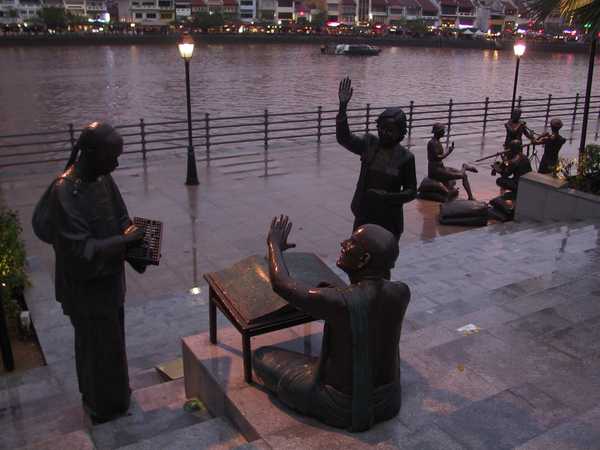From Chettiars to Financiers
First placed in Singapore: 2002
Singapore River, by Asian Civilisations Museum
-
Patron: ExxonMobil, supported by Singapore Tourism Board, National Heritage Board, and Singapore Land Authority
Once upon a time there was an art style known as socialist realism, that celebrated the workers' heros. So what do we call this? Capitalist realism? It quotes equally from this source, and a tourism-inspired hyperreallism. This sculpture is part of the series of realistic works that line the Singapore River's lower reaches (can the Singapore River be said to have upper reaches?). Certainly, between this and Millennium there are enough people 'reaching' - to the sky, to the stars, for inspiration? Notice the way the label on this piece references the Millennium work. Labels are starting to refer to each other...
Text of the Label:
From Chettiar to Financier[text in English and Chinese] Chern Lian Shan Sculptor Singapore's position as a centre for entrepot trade led to the proliferation of financial institutions. The settlement's first bank was the Union Bank of Calcutta established in 1846. Financial businesses set up their offices near the Singapore River to be close the the area's many trading houses.Early services were always along ethnic lines. The moneylending in the early days was primarly run by the Chettiars who came from South India. The Chettiars congregated at Market and Chulia Streets, and their offices were easy to spot. These usually comprised a clerk and a manager who sat behind a small low desk on a woven mat, as shown here. Clearing houses were the domain of the Chinese. Capitalising on abundant trade between Singapore and China, these companies thrived. Clerks, like this standing pig-tailed man, were a common sight as they bustled to and from offices in Commercial Square (Raffles Place). Today major local and multinational financial institutions provided a wealth of sophisticated financial services. On the trading floor of the Singapore Exchange almost every day, are hundreds of traders, whose distinctive jackets have become the symbol of economic growth. The tableau's lady trader hails the knowledge driven future, symbolised by the Millennium figure who leads the way to the Asian Civilisations Museum. A community project proudly sponsored by [logo of ExxonMobil] in collaboration with [logo of Singapore Tourism Board] [logo of National Heritage Board] [logo of Singapore Land Authority]
Last updated: Dec-5-2020
